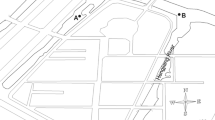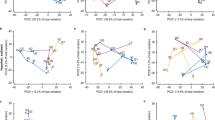Abstract
Microbial communities that developed on glass slides suspended in acid-polluted (pH=2.9) and nonpolluted (pH=6.5) but otherwise similar waters showed evidence of stress when suspended at the opposite station. Glucose incorporation was inhibited in both translocated communities, but the inhibition was not as severe and recovery of activity was faster for the acid-developed community as compared to the circumneutral community. The communities contained a substantially different set of members with little overlap. The range of pH values at which the members of the acid-developed community could function suggested that the members of that community were generalists, as opposed to narrowly constrained members of the community from the circumneutral station. Based on the proportion of test characters that received positive responses, the organisms from the acidic site were more general in their abilities (47.6% positive) as compared with the neutral counterparts (18.7% positive). The results support the concept that communities developed in extreme environments tend to be generalists, whereas those from mesic environments, due to the higher levels of competition present, tend to be specialists. Furthermore, the study of microbial communities in dynamic systems such as streams and reservoir inflows is facilitated by the use of solid surfaces which allow an assemblage of nontransient microbes to develop.
Similar content being viewed by others
References
Baker KH, Mills AL (1982) Determination of the number of respiringThiobacillus ferrooxidans cells in water samples by using combined fluorescent antibody-2-(p-iodophenyl)-3-(p-nitrophenyl)-5-phenyltetrazolium chloride staining. Appl Environ Microbiol 43:338–344
Carpenter JM, Odum WE, Mills AL (1983) Decomposition of leaf litter in a lake receiving acid mine drainage. Oikos 41:165–172
Dugan PR, MacMillan CB, Pfister RM (1970) Aerobic heterotrophic bacteria indigenous to pH 2.8 acid mine water: predominant slime-producing bacteria in acid streamers. J Bacteriol 101:982–988
Fletcher M (1979) A microautoradiographic study of the activity of attached and free-living bacteria. Arch Microbiol 43:122–127
Fletcher M, Marshall KC (1982) Are solid surfaces of ecological significance to aquatic bacteria? In: Marshall KC (ed) Advances in microbial ecology, Vol. 6. Plenum Press, New York, pp 199–236
Geesey GG, Mutch R, Costerton JW, Green RB (1978) Sessile bacteria: an important component of the microbial population in small mountain streams. Limnol Oceanogr 23:1214–1223
Guthrie RK, Cherry DS, Singleton FL (1978) Responses of heterotrophic bacterial populations to pH changes in coal ash effluent. Water Resour Bull 14:803–808
Haack TK, McFeters GA (1982) Microbial dynamics of an epilithic mat community in a high alpine stream. Appl Environ Microbiol 43:702–707
Harrison AP Jr (1978) Microbial succession and mineral leaching in an artificial coal spoil. Appl Environ Microbiol 36:861–869
Herlihy AT, Mills AL (1985) Sulfate reduction in freshwater sediments receiving acid mine drainage. Appl Environ Microbiol 49:179–186
Heukelekian H, Heller A (1940) Relationship between food concentration and surface for bacterial growth. J Bacteriol 40:547–558
Hobbie JE, Daley RS, Jasper S (1977) Use of Nuclepore filters for counting bacteria by fluorescence microscopy. Appl Environ Microbiol 33:1225–1228
Hugh R, Liefson E (1953) The taxonomic significance of fermentative versus oxidative metabolism of carbohydrates by various gram-negative bacteria. J Bacteriol 66:24–26
Kaper JB, Mills AL, Colwell RR (1978) Evaluation of the accuracy and precision of enumerating aerobic heterotrophs in water samples by the spread plate method. Appl Environ Microbiol 35:756–761
Kirchman D, Mitchell R (1982) Contribution of particle-bound bacteria to total microheterotrophic activity in five ponds and two marshes. Appl Environ Microbiol 43:200–209
Kjelleberg S, Humphrey BA, Marshall KC (1982) Effect of interfaces on small, starved marine bacteria. Appl Environ Microbiol 43:1166–1172
Ladd TI, Costerton JW, Geesey GG (1978) Determination of the heterotrophic activity of epilithic microbial populations. In: Costerton JW, Colwell RR (eds) Native aquatic bacteria: enumeration, activity, and ecology, ASTM STP 695, American Society for Testing and Materials, Philadelphia, pp 180–195
Lock MA, Wallace RR, Costerton JW, Ventullo RM, Charlton SE (1984) River epilithon: toward a structural-functional model. Oikos 42:10–22
Marshall KC (1976) Interfaces in microbial ecology. Harvard University Press, Cambridge, Massachusetts
McMahon RF, Hunter RD, Russell-Hunter WD (1974) Variation in aufwuchs at six freshwater habitats in terms of carbon biomass and carbon: nitrogen ratio. Hydrobiologia 45:391–404
Millar WN (1973) Heterotrophic bacteria population in acid coal mine water:Flavobacterium acidurans sp. n. Int J Syst Bacteriol 23:142–150
Mills AL (1985) Acid mine waste drainage: microbial impact on the recovery of soil and water ecosystems. In: Tate RL, Klein D (eds) Soil reclamation processes. Marcel Dekker, New York, pp 35–81
Mills AL, Maubrey R (1981) The effect of mineral composition on bacterial attachment to submerged rock surfaces. Microb Ecol 7:315–322
Mills AL, Wassel RA (1980) Aspects of measurement of diversity for microbial communities. Appl Environ Microbiol 40:578–586
Sheldon SP, Taylor MK (1982) Community photosynthesis and respiration in experimental streams. Hydrobiologia 87:3–10
Sneath PHA, Sokal RR (1973) Numerical taxonomy. WH Freeman, San Francisco
Wassel RA, Mills AL (1983) Changes in water and sediment bacterial community structure in a lake receiving acid mine drainage. Microb Ecol 9:155–169
Wichlacz PL, Unz RF (1981) Acidophilic, heterotrophic bacteria of acid mine water. Appl Environ Microbiol 41:1254–1261
Zobell CE (1943) The effect of solid surfaces on bacterial activity. J Bacteriol 46:38–59
Author information
Authors and Affiliations
Rights and permissions
About this article
Cite this article
Mills, A.L., Mallory, L.M. The community structure of sessile heterotrophic bacteria stressed by acid mine drainage. Microb Ecol 14, 219–232 (1987). https://doi.org/10.1007/BF02012942
Issue Date:
DOI: https://doi.org/10.1007/BF02012942




